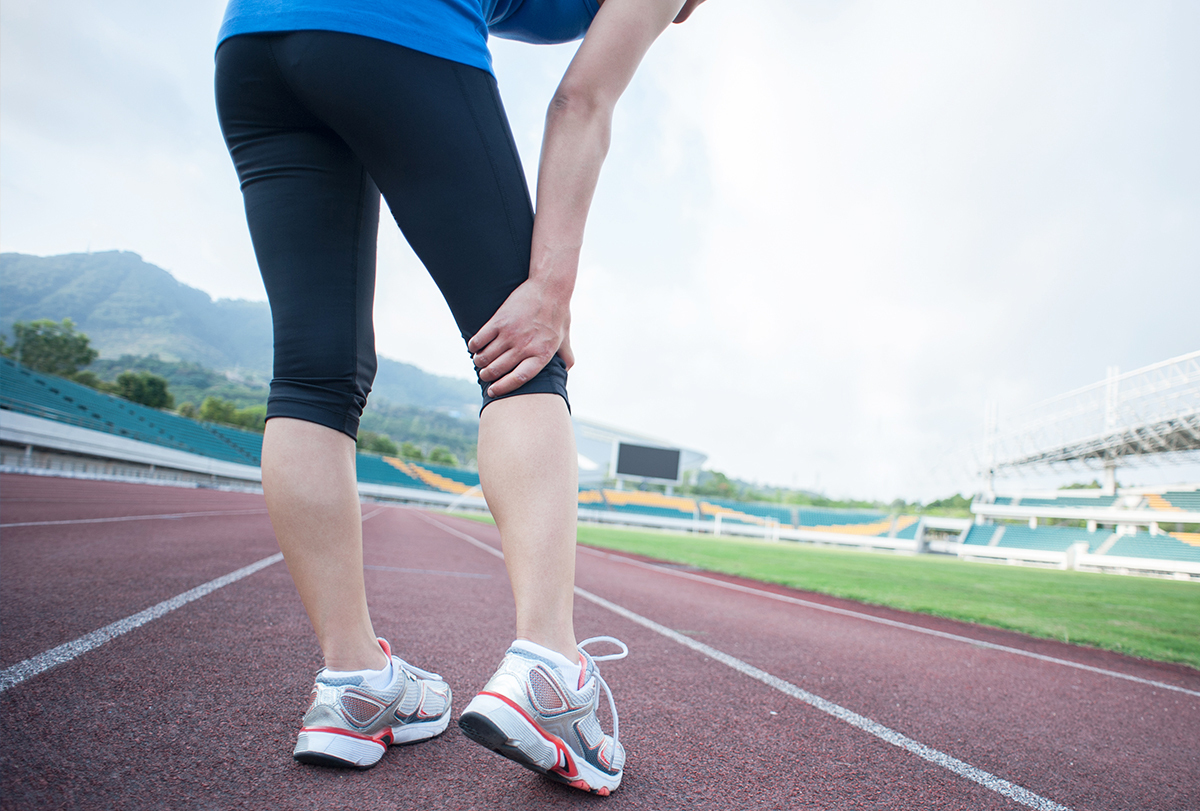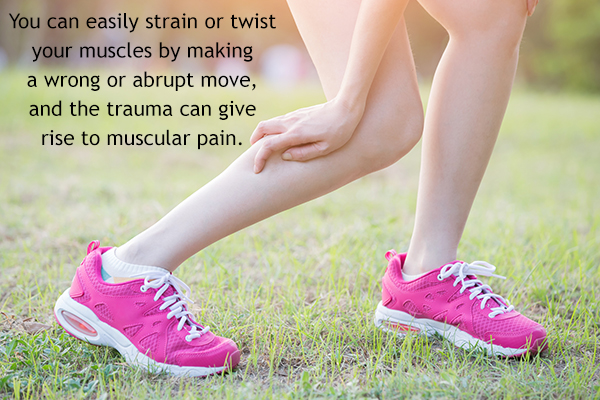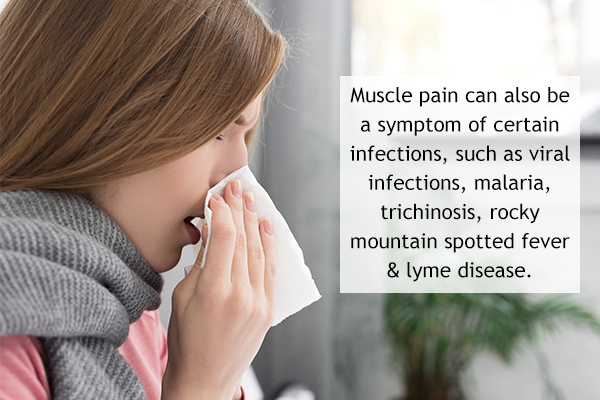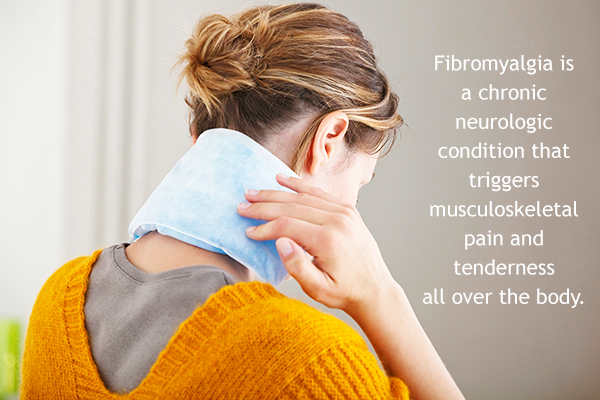In this article:
Muscle pain is fairly common in people of all ages and genders. Regular muscle pain is usually mild enough to be managed with proper rest, home therapies, and medication. However, the pain can sometimes be so intense that it can limit your mobility and keep you from accomplishing your daily tasks.

Muscle pain usually stems from trauma to a small group of muscles after intense or sudden physical activity. It may start during the activity or sometime after it.
Causes of Muscle Pain
Muscle pain can stem from a wide variety of underlying causes, which are broadly classified into the following categories:
1. Injury

- Muscle strain or tears: Pulling or tearing your muscle fibers in the event of an accident, sudden jerk, strenuous exercise, or intensive physical activity can give rise to muscular pain.
- Overuse injury: Performing the same motion again and again can tire and even damage the involved muscles overtime and trigger pain, weakness, numbness, loss of flexibility in the affected area. Such injuries are particularly common in athletes and can be temporary or permanent. Examples include carpal tunnel syndrome, swimmer’s shoulder, Achilles tendinitis, runner’s knee, jumper’s knee, shin splints, tennis elbow, and youth pitching elbow.
- Improper warmup: Doing some light stretching exercises before your workout helps increase blood flow in the body and loosen your tight muscles for greater flexibility. If you dive straight into the intensive exercises, the sudden physical jolt can rupture your muscle fibers, ligaments, or tendons. Therefore, you must start off light and gradually increase the intensity of physical activity to ease your body into it.
- Poor posture: Standing, sitting, or sleeping in an incorrect position can contort your muscles and disproportionately exert your body weight on specific points, which gives rise to pain in the area. Slouching in a chair, hunching the back, rounding the shoulders, leaning on one leg for too long, wearing high heels, and excessive abdominal weight can all strain the involved muscles.
- Compartment syndrome: Your limbs contain compartments of muscles and blood vessels encapsulated within a thin sheath of fibrous tissue known as fascia. Severe internal bleeding, tissue inflammation, or fluid retention can exert extreme pressure on these compartments and cut off blood flow to the affected area, thereby causing muscle degeneration.
2. Stress and tension
Increased stress can cause your muscles to contract or tighten up. This kind of muscle tension lies at the base of many common health problems, including tension headaches, migraines, and several musculoskeletal conditions.
3. Infections

Muscle pain can also be a symptom of certain infections, such as:
- Viral infections of the lower respiratory tract like influenza lead to congestion, cough, and labored breathing, which can strain your chest muscles and cause pain. In addition, the virus itself and/or the immune response to the infection can cause direct muscle injury and inflammation.
- Malaria is a highly contagious infection spread by the Anopheles mosquito, which is known to cause muscle aches, among other symptoms.
- Trichinosis is a parasitic infection caused by the ingestion of cysts (larvae, or immature worms) of Trichinella spiralis found in undercooked meat. This infection often causes joint and muscle pain, along with other symptoms.
- Rocky Mountain spotted fever is a potentially fatal infection caused by a tick bite which typically begins with a fever and a rash, but can also trigger muscle pain, headache, appetite loss, and stomach pain.
- Lyme disease is a bacterial infection that is transmitted to humans through the bite of an infected deer tick. This infection affects multiple organ systems in the body and is commonly associated with muscle and joint aches, among other symptoms.
4. Autoimmune diseases
Muscle pain can also be the result of certain autoimmune diseases like lupus or myositis wherein the body’s immune system attacks its own healthy tissue after mistaking it for foreign material.
5. Other diseases or conditions

- Polymyalgia rheumatica
- Fibromyalgia (1)
- Hypothyroid myopathy
- Chronic fatigue syndrome
- Electrolyte imbalance
- Statin drugs
- Peripheral arterial disease (PAD)
What Does the Location of Your Muscle Pain Tell You About Its Cause?
Muscle pain can manifest in two ways:
1. Localized muscle pain
This refers to the pain which can be felt only in a specific region, usually due to injury or overuse of the underlying muscles. This is the most common form of muscle pain which typically sets in during or after strenuous activity.
Since you know the exact location and trigger of the pain, it becomes easier to identify the root cause of the problem for targeted treatment and care.
2. Systemic muscle pain
This refers to the pain that encompasses the entire body and can be harder to trace back to a specific muscle injury. This kind of widespread muscle pain is usually triggered by an infection, illness, or certain medications that typically require medical attention.
Symptoms of Muscle Pain
Symptoms for muscle pain include:
Standard Treatment for Muscle Pain
Depending upon the cause and severity of muscle pain, your doctor may recommend any of the following interventions:
1. Medications

Your doctor may prescribe various medications to soothe your muscle pain, depending upon the underlying cause and other relevant health factors. Some of the most commonly used drugs for muscle pain include:
- Nonsteroidal anti-inflammatory drugs (NSAIDs) such as ibuprofen and naproxen, are often used for treating muscle strains, muscle injury, and myofascial pain syndrome.
- Muscle relaxants such as cyclobenzaprine (Flexeril) and tizanidine (Zanaflex), serve as first-line treatments for acute muscle injuries that cause muscle stiffness/spasm along with the pain.
- Antidepressants may help patients cope with long-term muscular pain that is otherwise hard to treat or may have neuropsychological origins.
- Corticosteroids such as prednisone and prednisolone, are prescribed in cases when the muscle pain stems from an underlying inflammatory condition such as polymyalgia rheumatica or other inflammatory myopathies.
- Steroid-sparing agents like Methotrexate help eliminate or minimize the need for steroid therapy to avoid some of its negative side effects. This medication is particularly useful for people with chronic ailments like rheumatoid arthritis.
- Vitamin D supplementation is important for treating muscle pain and weakness caused by osteomalacia or a general lack of vitamin D in the body. This nutrient is essential for the absorption of calcium and contributes to both bone and muscle health.
- Baclofen can help alleviate severe spasms when oral medication fails. The treatment usually involves oral administration or a continuous intrathecal administration of the drug through a pump.
- Liquid phenol may help relieve severe muscle spasms that do not respond to physiotherapy and other medicines.
Note: These drugs should always be prescribed and managed by a qualified health professional.
2. Surgery
Surgery may be recommended to correct orthopedic deformities and neurological dysfunction that may be causing muscle pain. Doctors typically perform such surgeries to restore movement, rectify posture, or relieve severe, ongoing muscle spasms.
Complementary Therapies
You can also try these alternative therapies either by themselves or along with the standard treatment, depending upon how bad your condition is and your doctor’s discretion.
1. Physiotherapy
Seek the help of a physiotherapist or your doctor to come up with a suitable exercise routine which can help work out and rehabilitate your damaged, weak or stiff muscles.
2. Acupuncture
Acupuncture is an ancient Chinese technique of inserting needles at specific points on the body to stimulate blood flow in the region for better delivery of nutrients and oxygen to the underlying body tissue. (2)
This can help repair the muscle damage and thereby reduce muscle soreness and pain in the area provided it is done correctly under the guidance of a professional acupuncturist. (2)
Diagnosing Muscle Pain

Muscle pain can stem from a wide variety of underlying conditions, which may warrant different kinds of treatment. Thus, determining the root cause of the pain is the first step toward treating it.
1. Medical history
Your doctor will start off by taking a detailed medical history, which is generally an inquiry about:
- The onset and progression of the disease
- Symptoms
- Things that make the condition worse or better
- Associated symptoms such as rash and fever
- Past medical history
- Family history
- Medication use
This preliminary information will help the doctor get a better understanding of your condition. Using these details, the doctor can rule out conditions that do not coincide with your symptoms or medical history and arrive at a diagnosis.
2. Physical examination
The next step in diagnosing muscle pain involves a thorough physical exam, wherein the doctor will press on various muscles to check for pain, tenderness, muscle strength, range of motion, balance, and gait.
3. Diagnostic procedures and tests
Oftentimes, a physical exam alone is not enough to establish the cause of your muscle pain, in which case your doctor may order a few tests such as:
- Blood tests to screen for elevated inflammatory markers, elevated muscle enzymes (creatinine kinase and/or aldolase), or antibodies that could indicate an autoimmune disorder or tissue injury.
- Electromyography and nerve conduction studies (EMG/NCS) to measure muscle tension on the basis of motor activity.
- Muscle biopsy to check for chronic muscular inflammation, atrophied muscle fiber, and vascular deformities to diagnose a specific type of inflammatory muscle disease.
- Skin biopsy to evaluate changes in the skin associated with dermatomyositis, an autoimmune condition in which the patient develops skin rashes along with muscle weakness.
- Magnetic resonance imaging (MRI) to reveal abnormal muscle anatomy or deformity.
- CT scan to check for muscle injury.
- Ultrasound to detect muscle inflammation.
- Blood chemistry and/or urinalysis as by-products of muscle breakdown are filtered through the kidney. The levels of these by-products are assessed to ensure that no damage to the kidney is occurring as a result of the muscle breakdown. (3)
Risk Factors for Muscle Pain
Muscle pain is relatively common, but some people are more prone to it than others. This problem is particularly prevalent in infants, young children, and older adults above the age of 65 years.
The following factors can put anyone at an increased risk of developing muscle pain and cramps:
- Being overweight
- Excessive alcohol consumption
- A family history of statin intolerance
- Certain medical conditions, such as hypothyroidism
When to See a Doctor
Call your doctor if:
- Your muscle pain persists for more than 3 days or worsens, despite proper care and preliminary RICE treatment.
- You have severe muscle weakness such that you are unable to move the affected part.
- Your pain is so severe that you cannot bear it.
- You notice color changes, swelling, or warmth at the affected site.
- You experience dizziness, vomiting, neck stiffness, fever, breathing problems, or difficulty swallowing along with the pain.
Final Word
Everyone suffers from muscle strain from time to time, but it usually resolves with a little rest and self-care.
Moreover, most cases of muscle injuries can easily be avoided if you follow the necessary precautions before taking on any demanding physical work. Muscles become tense and knotted when they remain out of use, so you must always stretch them out before exercise.

- Was this article helpful?
- YES, THANKS!NOT REALLY


